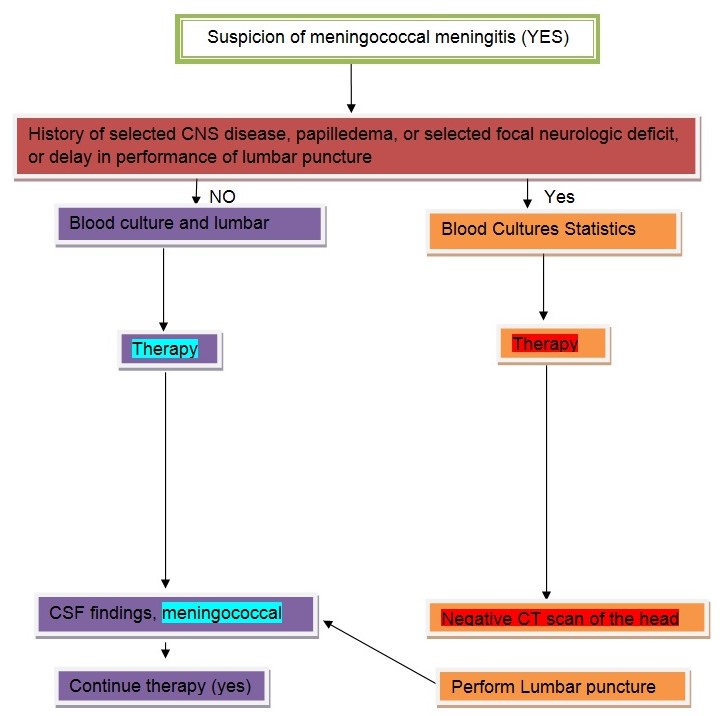Introduction
An algorithm for meningococcal meningitis is a formula that is designed to control and treat the problem (Lombardo & Buckeridge, 2007). The algorithm will help practitioners to easily track the disease. The intervention is not labor-intensive.
Indicators of the Algorithm
One of the indicators to be used is blood cultures (Taubenberger & Morens, 2006). Blood cultures can provide information on whether or not there are bacteria or fungi in the body system (Lombardo & Buckeridge, 2007). Lumbar puncture is another indicator that is important to this case. Lumbar puncture is a medical procedure that is carried out on people affected by meningococcal meningitis (Ryan, 1989). Tests on cerebrospinal fluid (CSF) will also be carried out in the process of creating the system. Computed tomography (CT) scan is another indicator that will be used (Ryan, 1989). Dexamethasone and empirical antimicrobial therapy is the last indicator of the problem.
Logical Process of the Algorithm

The diagram shows an algorithm for meningococcal meningitis. Individuals suspected of having the problem are grouped into two. The first group includes those patients with a history of the problem (Artenstein, 2013). The second is made up of those without a history (Kulldorff, 2001). Findings from blood culture are recorded for both groups. Dexamethasone and empirical antimicrobial therapy will be applied as shown in the diagram. Patients with a history of the problem need to undergo a CT scan. If the results are negative, the individual will undergo a lumbar puncture. Patients without a medical history of the problem will have a CSF test. If the test shows the presence of the disease, patients from both groups will continue with therapy (Artenstein, 2013).
Salient Features
In addition to the procedures in the algorithm, the medical history of the patient will be important (Kulldorff, 2001). Records of persons with a history of the problem are the only salient feature in the algorithm (Brookmeyer & Gail, 1994).
Strengths and Limitations of the Algorithm
The major strength of the algorithm includes its ease of use. The formula clearly stipulates the channels to be followed when dealing with the problem (Taubenberger & Morens, 2006). The algorithm saves time during treatment (Lombardo & Buckeridge, 2007). With regards to limitations, the algorithm can only be used on adults. Children are delicate, especially when it comes to head scans.
Conclusion
It is important to use an algorithm when dealing with meningococcal meningitis. The medical condition is rare and researchers have not yet established the best way to deal with it. Putting a formula in place will help to deal with the problem easily and within the shortest time possible.
References
Artenstein, A. (2013). In the blink of an eye: The deadly story of epidemic meningitis. New York: Springer-Verlag.
Brookmeyer, R., & Gail, M. (1994). AIDS epidemiology: A quantitative approach. New York: Oxford University Press.
Kulldorff, M. (2001). Prospective time periodic geographical disease surveillance using a scan statistic. Journal of the Royal Statistical Society, 164(1), 61-72.
Lombardo, J., & Buckeridge, D. (2007). Disease surveillance: A public health informatics approach. Hoboken, NJ: Wiley-Interscience.
Ryan, T. (1989). Statistical methods for quality improvement. New York: Wiley & Sons.
Taubenberger, J., & Morens, D. (2006). 1918 influenza: The mother of all pandemics. Emerging Infectious Diseases, 12(1), 15-22.